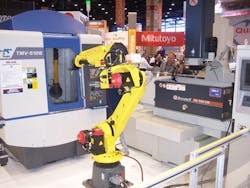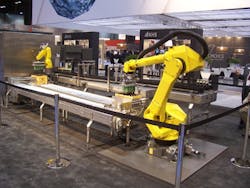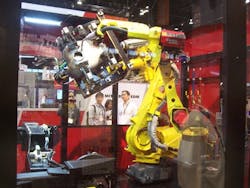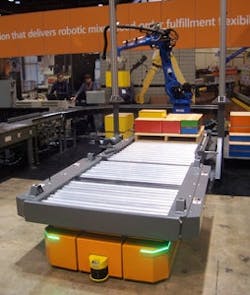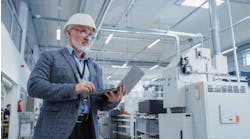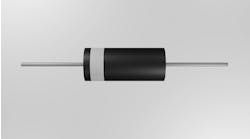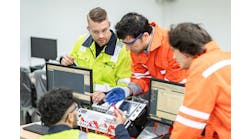Jim Montague is the executive editor for Control and Control Design. Email him at [email protected].
Robots used to be a big deal. Forests of huge yellow, orange and white arms juggled and welded car bodies, and everyone else looked on in awe at their amazing moves and equally huge price tags.
Times have changed, and many robots appear to be showing off less, even as they do more and different jobs. They're diversifying in their sizes, skills, applications and costs, and so mom-and-pop end users can now afford to use them to pack tortillas, pick and place candies, or perform material handling and other smaller-ticket tasks. As a result, many robots are settling into lives of calmer domesticity, and serving in less glamorous, more unassuming roles in many machines, work cells and production lines next to traditional equipment.
To better coordinate these joint efforts, controllers and software are gaining the ability to add robots as regular devices in the repertoire of machine tools, conveyors, motors and other equipment they're already controlling. Surprisingly, some users are finding that older gantry robots and x-y-z motion systems can take on some of the jobs for which they initially thought they'd need a newer robot. Conversely, a few robot controllers are adding external devices and functions to the tasks they're already managing. In short, some robots are integrating so closely into their machines that they're becoming seamless and almost invisible in some cases.
Go-Between Simplifies
No doubt the most frequent example of robots breaking free of previously inflexible roles has been relocating them between machining centers to load and unload materials and parts that used to be handled manually. Some robots are even installed on rails, so they can roll between machines and cells and serve more of them.
For instance, Absolute Machine Tools in Lorain, Ohio, and its electrical discharge machining (EDM) division in Mason, Ohio, have been integrating robots into their EDM processes for a couple of years. Absolute is an importer and distributor for Taiwan-based Tongtai Group, and so it recently developed a robotic interface between its Accutex DS-550 EDM die-sinking machine and Tongtai's TMV-510G graphite machining center by using Fanuc’s M-20iA robot and 31iMB controller (Figure 1). The machining center produces customized electrode tooling as needed, which the die sinker can use to make a greater variety of it own products. EDM machines use charged wires and other components to remove metal and create intricate and specialized molds and other parts that can't be made by other processes.
Figure 1: Absolute Machine Tools' EDM division recently integrated its die-sinking machine with a graphite machining center by using a robot and controller.
(Source: Jim Montague)
See Also: Manufacturing Workers - the Next Generation
"We knew about Tongtai and Johnford machines in Taiwan that already incorporated a robot right into a machine, but our EDM group's technical director, Mark Cicchetti, had the idea of moving the robot outside the cell, so we could use it with existing machines," says Michael Barr, service operations manager at Absolute. "Most EDM machines already have tool changers with different electrodes, and so the next logical step is machining just the particular size that's needed for a job. The initial CAD program for a tool goes into the machining center, which tells the robot when it's done, and whether to transfer the tool to the die-sinking machine. The robot and machines communicate serial data via Ethernet and RJ45 connections. We were able to integrate this project in about 30 days, and we became certified Fanuc integrators in the process."
Barr adds that bringing the machining center, robot and die sinker together is enabling Absolute to improve the productivity of its customers, especially when they're programming and preparing electrodes and work pieces and making the builder more globally competitive. "Users can spend $35,000 to $40,000 on a traditional tool changer with a shuttle and carousel, but the EDM machine still only has a limited number of electrodes," adds Barr. "Adding a machining center and robot means the EDM machine can access an unlimited number of electrodes, change work pieces in and out automatically and do off-line set up of the next job while the machine is running. This means less idle spindle time. Saving the 15-30 minutes on average it takes to set up a typical 3.5-hour EDM job might not seem like much, but over 24 hours it can allow a user to produce seven parts per day, instead of six. At about $210 per job, this can add up to an extra $46,000 per year and maybe pay for another operator."
Flexibility Fuels Acceptability
While some machine builders are new to adding robots, others have been integrating them for years, and many of these are in the packaging industries. Sean Wells, senior robotics product manager at KHS USA in Waukesha, Wisconsin, reports his company has been working with robots since 1996 because its customers wanted greater flexibility in their filling and packaging applications, and KHS found that robots allowed them to change product types and package sizes more quickly.
"Robots in packaging started out in palletizing and depalletizing, and then smaller robots began to be used for case packing and decasing," says Wells, who reports that KHS usually deploys Kuka robots in Germany and implements Fanuc and Kuka robots in the United States. "More end users are coming to appreciate what robots can do for them. They're learning that robots are reliable and don't use black magic and that the maintenance staff can easily interact with, tweak and maintain them. Previously, robots had to be hard-coded and needed a programming guru to program their moves. These days, we can teach users to adjust robots to handle their differently sized products in about 5 minutes and be comfortable with it. Also, robot manufacturers are making their interfaces easier to use, and so we're designing robots to be just another part of the overall machine system appearing on KHS' and the user's operations screen. It also helps that the cost of small robot is about 45% less than it used to be."
To help users and retailers pack multiple different flavors of bottled beverages in one case and avoid doing it manually, KHS recently used robots to develop its new rainbow- and family-type bottle handling and packing system during eight months of layout and design (Figure 2). "There are mechanical ways to do this, but robots are more reliable longer, and they're flexible enough to meet users' constantly changing needs. In this case, running 24 loose bottles, four six-packs or two 12-packs," explains Wells. "These customized cases used to be seasonal, and so users would hire 20 temporary staff for two months. However, this variety is now in demand year-round, and so users want to automate."
Figure 2: KHS' rainbow- and family-type bottle-handling system employs two robots, which have their own robot and motion controllers, talk via EtherNet/IP to a PLC and a safety PLC to achieve dual-channel safety, and can pack cases of 24 loose bottles, four six-packs or two 12-packs.
(Source: Jim Montague)
Wells reports KHS' new bottle-handling system coordinates two different Fanuc robots, which have their own robot and motion controllers, and talk via EtherNet/IP to a ControlLogix PLC and a GuardLogix safety PLC from Rockwell Automation. They're located on the system's common, DIN-rail backplane and provide dual-channel safety. The GuardLogix PLC is wired to all safety-rated devices, such as e-stops, door interlocks and light curtains, and so they no longer need redundant safety relays. The bottle-handling system also includes Rockwell's Powerflex 525 variable-speed drives, Sick or Rockwell photo eyes to check for defects, SMC pneumatic pushers and SEW inverter-duty gear motors.
"The PLCs tell the robots when a particular case needs to be packed and what its specifications are, and the robots tells the PLCs when they're finished with that task," adds Wells. "Performance data is exchanged when they make these handshakes."
Merging Tools and Machine Tasks
Once robots become adept at moving materials and products between machining centers and processes, the next questions in the never-ending quest for efficiency are: do they need to be moved at all, and can't those separate processes be merged? For instance, Tennessee Rand in Chattanooga, Tennessee, was a job shop for 35 years, started building manual welding fixtures 25 years ago and more recently moved into robotic welding cells. It was bought by weld-wire and power-supply manufacturer Lincoln Electric in Cleveland, Ohio, in January 2013 and is now part of the Advanced Automation Solutions division. Its high-volume turntables, Ferris wheels and other fixtures and work cells typically help to hold and move automotive frames and other heavy parts, and so it's keenly aware of coordinating the loading, movement and weld times between its tooling and work pieces.
"We began building robots into our weld fixtures because the traditional, manual clamps were slower and less accurate. Pneumatic clamps along with robotics and gray-box PLCs like MicroLogix made our MIG- and spot-welding fixtures smart and allowed us to work with other plug-and-play fixtures," says Eddie Ramsey, advanced welding systems sales manager in the Lincoln Electric Advanced Automation Solutions division. "We usually bring in robots as part of an end-of-arm solution and marry the tooling with the cell for a turnkey solution. Each of our cells typically process 100,000 to 2 million parts per year, which determines how many robots and the layout they need."
When the former Tennessee Rand initially deployed robots, its work cells were arranged sequentially by machine function, and the robots mostly served as transfer systems between the cells, explains Ramsey. Over time, however, robots were used to combine multiple machining processes. Likewise, where separate end-of-arm tooling used to be required for welding and pickup tasks, some robots can now do both with just one tool and coordinated controls. For example, the firm's H-frame positioner or turntable employs two Fanuc robots, including an Arc Mate 100iC welder and an R-2000 iB material handler and spot welder (Figure 3). The robots have their own controllers, but the overall cell is networked via EtherNet/IP and managed by a ControlLogix PLC and GuardLogix safety PLC, while tools on the positioner are controlled by a MicroLogix PLC, all from Rockwell Automation. The robot controller gives the welder the best possible motion profile, but it also can run four different types of parts, which previously took four production lines.
Figure 3: To weld and pick-up materials with one tool and make different parts in one work cell, the H-frame positioner or turntable employs two robots, including a welder and a material handler and spot welder that have their own controllers, while the overall cell is managed by PLCs.
(Source: Jim Montague)
"We learned that a robot that could do the first job might also be able to do the second, third, fourth and fifth jobs in one larger cell," explains Ramsey. "This was a big gain, but it also required closer integration. Fortunately, we can also use 3D CAD design and robot simulation software, such as Fanuc's SimSoft and Motoman's MotoSim, to build integrated cells much more easily, check on access, work out bugs and see and avoid potential crashes. Today's robots are also faster, can carry heavier payloads, include more features and have better software. This means we can stamp and laser-cut more parts, which is preferable, while traditional equipment has to cut and weld parts, which are rougher and need more finishing."
Arms Get Legs, Er, Wheels
Inevitably, once robots get unbolted from plants floors and into rails, the next logical step is jumping the tracks for even more freedom of movement, greater coverage and more service to related equipment and facilities. These capabilities are crucial for today's businesses trying keep up with the demands of Internet-enabled customers hungry for individualized, just-in-time manufacturing and immediate deliveries.
"E-commerce and dot-com businesses inside and outside the United States, mass customization of products and smaller levels of sortation are driving opportunities and growth for many manufacturers and their material handling, packaging and other suppliers," explains Chris Cole, CEO at Intelligrated in Mason, Ohio.
Figure 4: Intelligrated's mixed-load, order-fulfillment system consists of 50-kg- and 300-kg-capacity robots, which are assisted by mobile AGV robots that deliver and retrieve loads for depalletizing, sorting and repalletizing.
(Source: Jim Montague)
To help all these ramped-up suppliers process their increasingly customized orders, Intelligrated has developed a combined, high-palletizing system, including an automatic case depalletizer with vision system, mixed-case palletizer, stacker/wrapper that builds loads on a wrapping platform and automated-guided-vehicle (AGV) robots for transferring loads (Figure 4). This unified system is also aided by Intelligrated's Alvey robotic, mixed-load, order-fulfillment system, which consists of Yaskawa's Motoman MPC300 300-kg-capacity robot and Motoman MH50 50-kg-capacity robot. Depalletizing is guided by Universal Robotics' camera and PC-based vision system, while other functions are monitored by Microsoft's Kinect sensor and camera. The two robots are controlled by Rockwell Automation's ControlLogix L61 PLC via EtherNet/IP and Intelligrated's mixed-load palletizer software. The AGVs also use Sick proximity sensors, Wi-Fi wireless networking, MicroLogix PLCs to control their onboard conveyor and simultaneous localization and mapping (SLAM) to orient themselves in each facility. The smaller robot performs order picking, while the larger robot builds and wraps completed pallets.
"These jobs used to require a lot of manual labor, but now we can take manufacturing processes and robotic technologies into the warehouse and integrate many of these functions together," adds Cole. "The overall solution, including the mixed-load and vision systems, took a couple of months to develop. The robots also use Motoman's cube interference process, which sets up areas that the robots can't go into because they're unauthorized or unsafe. We also set up functional safety units and boundaries for the operators that are constantly monitored."
Matthew Wicks, PE, systems engineering vice president for Intelligrated's Manufacturing Systems division, adds, "Building a pallet is like doing a Tetris puzzle, but we can tweak our mixed-load palletizer software to favor stability over density, and our ControlLogix 71S PLC and GuardLogix safety PLC on our robotic palletizers let us react to changes more quickly and complete changeovers faster, too. This is because we require less PLC programming now and it's easier to add new hardware and software when needed."
Mike Wagner, global segment leader for packaging at Rockwell Automation, says, "Robotics is a mature segment, and so OEMs that started out adding robots are now experienced robot integrators who may know more than the robot supplier. There are also many more robot users now, which helps because robots have gone from being separate islands to being coordinated with all the systems in the application. Also, instead of buying turnkey robots, some builders are even designing their own mechanics for in-feed and out-feed functions, and using one controller to manage the machines and robots in the work cells, instead of the usual two or more, which performs better and is less costly. This also gives the machine builder more margin because it doesn't have to share revenue with a robot supplier and distributor. Even if they haven't implemented robots before, most OEMs can approach a project like this because they've worked with belts, pulleys and servos to control x-y-z axes. These devices have been around for many years, and so builders may not think of them as robots, but that's essentially what they are, even though they're a different style."
Moving Safely, Ensuring Independence
Not surprisingly, as builders pack more machine equipment and robots into the same or smaller work cells and production lines, the potential for collisions and other unsafe situations increases. Granted, 3D design software can help coordinate these components, but safety PLCs and other safety devices and procedures are needed to ensure safe operations.
In recent years, many machines and work cells have added safety software that enables them to reduce power to safe levels in selected sections or only turn at safe speeds and in safe directions when operators get into their predefined work areas. More recently, robots are becoming part of these safety environments, too. In fact, some have mathematically defined operating envelopes that are constantly monitored as they move, which means their programming stops them, shuts them down or puts them in a safe state when they come into contact with any unauthorized structures or entities, such as barriers, other robots or operators.
For example, Aagard Group in Alexandria, Minnesota, has built packaging machinery for about 18 years. It was an early adopter of servo drives and servo motors, and it pioneered constructing large, combined systems that merge cartoners, case packers and palletizers that all formerly ran as separate machines. Tying together multiple operations allowed Aagard to run them with a single controller, such as Rockwell Automation's ControlLogix PLCs for large systems with 30-50 servo axes, CompactLogix PLCs for smaller applications with just four or five servo axes, and GuardLogix safety PLCs for safe operations and to comply with ANSI Cat. 3 safety requirements. To further ensure the safe operations of its machines and combined packaging systems, Aagard's robots are typically integrated with the machine's perimeter guarding, such as Cat. 3 locking guard doors. Other openings are protected with light curtains or other safety devices.
"Our strong suit is fitting our machine into available space by working closely with architects, CAD files and product flow sequencing, but we've also learned that what can be done with robots is similar to what we've already done with servos," explains Jason Norlien, Aagard's sales engineering manager. "Similar to servos, robots are also proven mechanical constructs that can be reused in many applications. So, where we've previously made gantry, x-y-z axis and linear motion robots, in the past year, we began making production machines with robots and a single controller."
Lately, Aagard has been buying off-the-shelf robot arms with installed gearboxes from Codian Robotics and then installing Rockwell Automation's Kinetix servo drives and servo motors and Kinematix motion control software and then programming them in the same manner as traditional x-y-z axes or servos. "This lets us better coordinate the robot's motor with the machine's other devices, simplifies our interface and makes starts, stops and fault recoveries very intuitive because we don't need all the usual handoffs and handshakes required when using two or more controllers and software programs," explains Norlien. "The robot becomes just like another servo axis on a machine, and this saves time on programming, troubleshooting, setup and configuration. A year ago, we had no machines with robots, and now we have nine machines running 24 different types of integrated robots, and they're reducing our construction time, improving machine longevity and reducing points of failure."
One recent development that's really going to help robots, machines and operators work more safely together are some eye-popping advances in safe robotic motion and touch sensitivity. Imagine a robot with no barriers, which slows and stops when operators touch it, just as if they'd brushed a human colleague's arm. For instance, Fanuc's collaborative robot arm prototype has a safety-rated, contact-stop capability and a hand-guided dance function that allows users to physically guide the robot through its learning process.
Likewise, Staubli in Duncan, South Carolina, reports that machine safety directives, such as ISO 10218, are enabling robots to come out of their cages, but they need to run in enhanced, dual-channel safety mode, which uses two CPUs to provide redundant safety. This is an improvement over single-channel, dual-safety methods used previously, according to Sebastian Schmitt, Staubli's North American division manager, who adds that his company will release new, proprietary, PC-based safety controls in March 2015. These controls will use SZ-04M safety laser scanners from Keyence to detect intrusions in several zones with progressively urgent alerts and alarms.
"Two redundant signals are needed to give feedback to the CPU, so they can control each other and ensure safe zone operations," says Schmitt. "This solution lets each axis report where it is in relation to the rest of its environment, which will enable users to program safe zones and safe stops while the equipment is still powered. This means fewer cages and less cost, but it will keep operators safe even as they work more closely with their robots and machines."
There are several basic steps in selecting and integrating a robot into a machine, work cell or production line. They include but aren't limited to:
- reexamining end users’ primary business, production and performance goals
- identifying operational pain points, bottlenecks and other areas where too many mechanical components or manual manipulations are required to complete tasks
- investigating whether some kind of robotic movement, end-of-arm tooling or other solution can be incorporated into existing or redesigned production process to combine several former operations or otherwise improve coordination and increase throughput
- comparing robotic options, hardware, programming and maintenance requirements among available solutions and determine which most efficiently and least expensively perform required functions and resolve former bottlenecks (while a multi-axis robot may be recommended in many cases, a traditional gantry robot or other x-y or Cartesian equipment may be just as useful in some applications, but will be much less costly, and so they should also be examined before picking a more expensive solution)
- conducting a risk assessment of the application into which the robot will be integrated and making sure the planned robot has the safety controls and capabilities to perform in that application without injuring staff or damaging itself or other equipment
- knowing what data connections the robot can make and how to secure its communications
- examining operational structure of robot controllers and overall system controllers (decide which controllers will carry out which functions in which areas, and determine which have priority and jurisdictional authority over the others in which situations)
- checking on networking, interfaces and interactions between core controls, machines and robots and their support equipment and other accessories
- conducting regular reviews, performing required maintenance and seeking new efficiencies for machines, robots and other equipment throughout their lifecycles.

